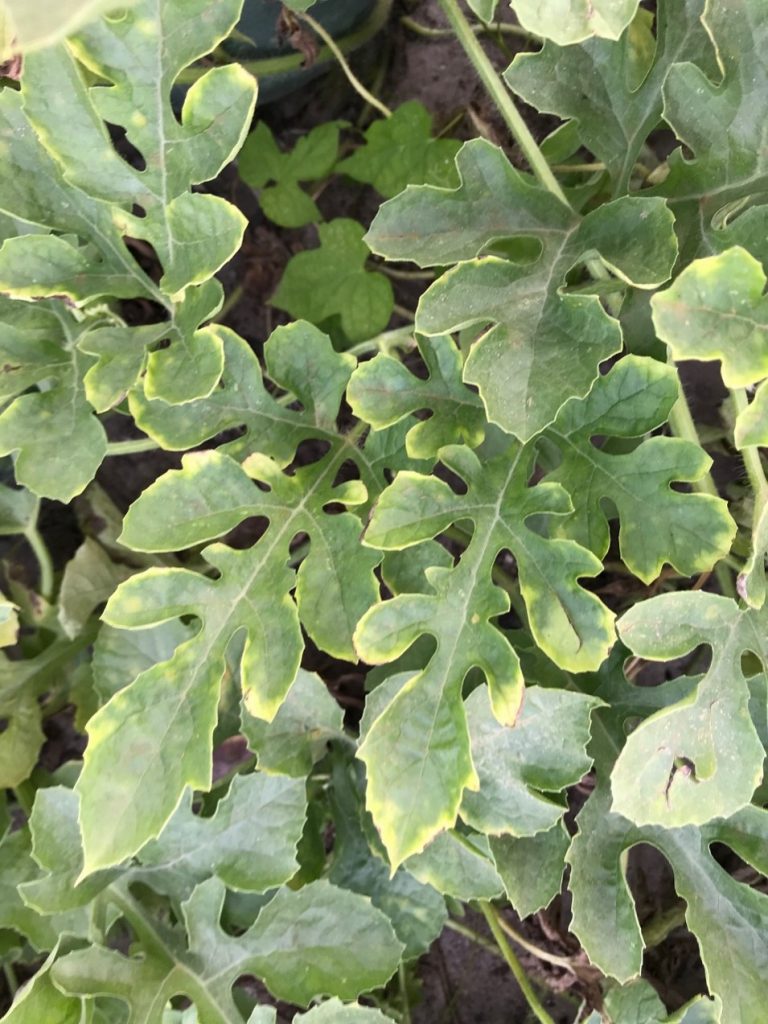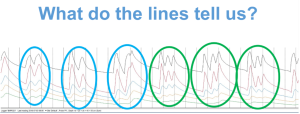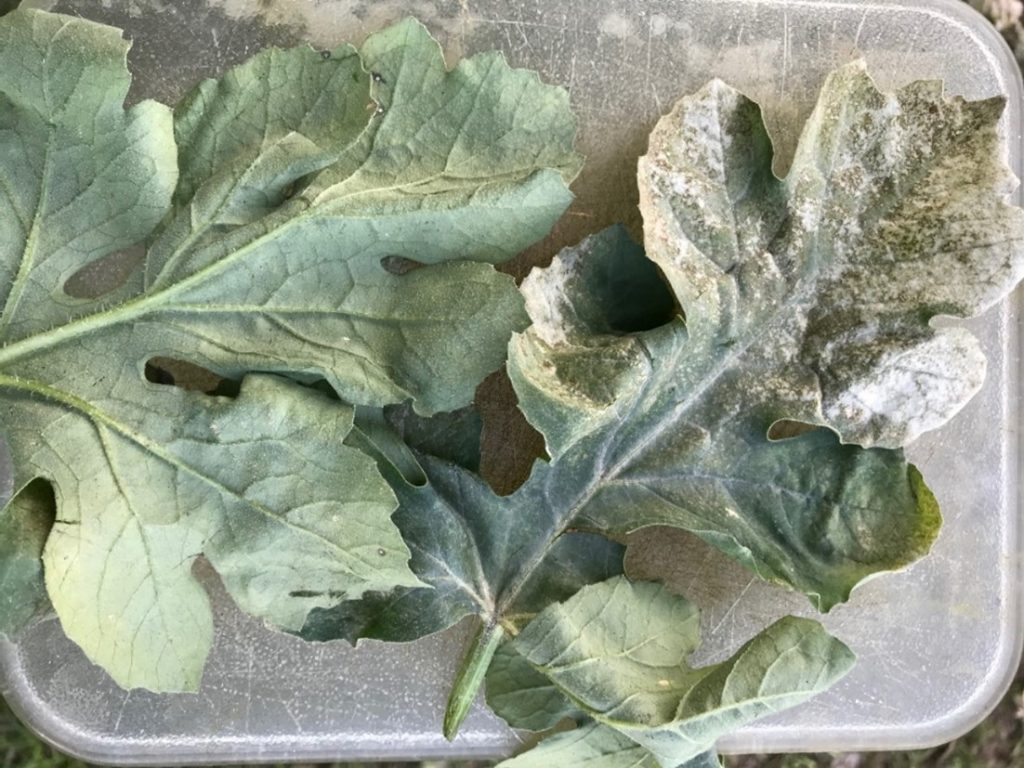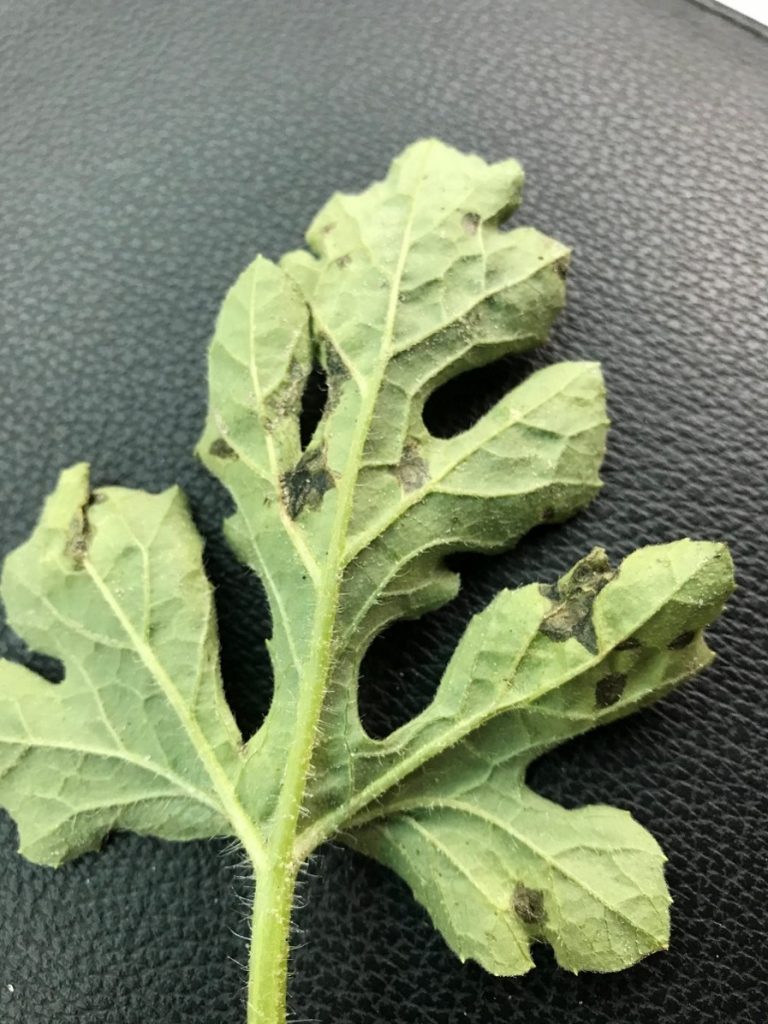Welcome to this week’s issue of our 2024 season UF/IFAS Extension Suwannee Valley Watermelon Crop Update. These updates will be summarized by Bob Hochmuth, Regional Specialized Extension Agent- Vegetable Crops, with input from Suwannee Valley Extension Agents: Mark Warren (Levy), Tyler Pittman (Gilchrist), Tatiana Sanchez (Alachua), Luke Harlow (Bradford), Dan Fenneman (Madison), Keith Wynn (Hamilton), Emily Beach (Lafayette), Jim Devalerio (Union), De’Anthony Price (Jefferson), Raymond Balaguer(Suwannee), Kevin Athearn (RSA-Agri- business), Shivendra Kumar (RSA-Agronomic Crops), Jay Capasso (RSA- Water Resources), and Bob H. covering vacant Columbia County position.
–
Disease Update
During the week of April 15-22, we have begun to see some changes in disease detection. We are beginning to see and confirm bacterial leaf spot and alternaria leaf spot. Incidence of these two diseases has been pretty isolated to specific fields and not widespread enough for this to be an overall alert, but rather a reminder to check on fields more closely now. Previously, we had only really seen confirmation of gummy stem blight in the Suwannee Valley. The good news, still no powdery mildew or downy mildew have been detected to date.
Based on field visits last week, I see the greater concern and recommendation to be on the lookout for bacterial leaf spot. The symptoms (see photo below) include black, wet looking spots with the borders of the spots being very black. (See pages 54-55 in the UF/IFAS Watermelon Field Guide). In most cases, the incidence of bacterial leaf spot has been very minor and has not warranted a specific treatment. In cases where treatment of bacterial leaf spot is justified, we recommend mancozeb (Manzate, Penncozeb, and other trade names) plus a low rate of copper fungicide (no more than 0.5 lbs active ingredient per acre). We do not recommend mixing copper with chlorothalonil due to increased risk of burn when these two are combined. Also remember, most cucurbit vine crops, including watermelon are very sensitive to copper, especially at the higher rates above 0.5 lbs active ingredient per acre. So, we do not recommend continuation of copper in watermelons unless very specifically needed. If needed, use it, if not justified, don’t use it! (See pages 20-21 in the UF/IFAS Watermelon Field Guide for copper toxicity information). Bob Hochmuth
–

Copper Toxicity symptoms of bright yellow leaf perimeter from spraying high rates of copper fungicides in Watermelon. Credit: Bob Hochmuth, UF/IFAS
–
As a reminder from last week’s update, here is our guidance to share, if gummy stem blight or powdery mildew are a concern in your fields. If gummy stem blight is not present in your fields yet, this would be the best time to use Miravis Prime as it is better positioned ahead of infection, not after gummy has gotten well established. Miravis Prime has some activity on powdery mildew too, but we encourage you to add a material like Quintec, Procure, or Rhyme to Miravis Prime to get ahead and stay ahead of powdery mildew. We have added Rhyme to our recommended powdery mildew list for 2024, based on university research trials in the southeastern US. This could be followed by mancozeb and possibly tebuconazole, plus the alternating powdery mildew material (Quintec, Procure, or Rhyme). UF/IFAS consistently ranks Inspire Super in the top performer category for gummy stem blight as a curative spray, but it has a 7-day preharvest interval (PHI). So, as you approach harvest, remember you need 7 days before your harvest. However, once you get into harvest season, and if you have already sprayed Inspire Super or are at less than 7 days to next harvest, what should you use? In those cases, Aprovia Top would be a good option. Aprovia Top has performed very similarly to Inspire Super in most trials and Aprovia Top has a 0-day PHI on the label. The main caution is that both Inspire Super and Aprovia Top have FRAC Group 3 fungicides in their ingredients, so we want to minimize the number of applications of these two in rotation. Keep in mind Aprovia Top is a great option, if needed, once you start the harvest season. A final note regarding spray programs once harvests start, pay close attention to pre-harvest intervals (PHI). Common rotations after harvests begin will include the following materials: Mancozeb (Manzate, Penncozeb) which has a PHI of 5 days, Quintec 3-day PHI, Procure 0-day PHI and Rhyme 0-day PHI. Aprovia Top has a 0-day PHI and Miravis Prime has a 1-day PHI. But other materials like tebuconozole, Inspire Super, and Luna Experience all have a 7-day PHI, so be alert to the PHI and your harvesting schedule and food safety records. Because Inspire Super and Aprovia Top both share difenoconazole, you need to remember not to exceed the 0.46 lbs a.i/A/year. (updated by Bob Hochmuth 2024, from Tatiana Sanchez-Jones, and Mathews Paret in 2023).
–
General Crop Observations and Irrigation Guidance
Last week was a period of rapid growth and plenty of fruit set everywhere in the region. We also noted a significant increase in water demand as the fruit were setting or expanding in size. Keep a close eye on soil moisture sensors in the upcoming weeks to adjust water events as needed. Watermelon production relies on precise irrigation management for optimal growth. Getting the duration and frequency of irrigation right is crucial for using water efficiently and achieving a successful harvest.
–
Understanding Irrigation Duration
Based on our experience, utilizing drip tape with a flow rate of 0.4 gallons per 100 feet per minute, it’s important not to irrigate longer than a duration of 1 – 1.5 hours in any single irrigation event (do not count the time it takes to pressurize the drip irrigation system in the total run time). Since watermelon roots typically extend to depths of 12 – 15 inches, irrigating longer than 1.5 hours, at this flow rate, leads to water leaching below the root zone in our sandy Suwannee Valley soils. When water leaches below the root zone it is no longer useful to the watermelon crop and risks leaching nutrients.
–
Irrigation Frequency: Twice (or thrice) is Nice

SMS Image: The blue circles show a watermelon grower struggling to maintain soil moisture (especially in the deeper zones) with just two daily irrigation events. However, increasing irrigation to three events per day improved moisture consistency across the root zone. Photo credit: Charles Barrett and Bob Hochmuth.
Instead of irrigating once a day for 3 or 4 hours a strategy of shorter, more frequent, irrigation events is more beneficial. Dividing daily irrigation into two 1 – 1.5-hour sessions throughout the day better aligns with the watermelon’s ability to absorb water in the root zone; this strategy also minimizes the risk of leaching. Some growers may benefit from irrigating even more than two events a day. See image 1 below of soil moisture sensor data showing how a watermelon grower increased the amount of irrigation water in the root zone by switching from two long irrigation events to three shorter irrigation events daily. As a result, he was able to better maintain a stable level of soil moisture in the root zone.
–
Tailoring Irrigation to Different Drip Tape Flow Rates
Not all drip tape flow rates are the same. With reduced flow rates, it takes longer to saturate the watermelon root zone adequately, extending the necessary irrigation time. For growers using lower drip flow rates, such as those ranging from 0.22 to 0.25 gallons per 100 feet per minute, growers should avoid irrigating more than 2.7 hours (approximately 2 hours and 40 minutes).
–
How Can I Tell if I am Irrigating Correctly?
A soil moisture sensor can help you determine if your irrigation event is too long or too short. With a soil moisture sensor, utilizing sensors at various depths, you can run an irrigation event and determine how deep sensors record increased moisture content from the irrigation event. If irrigation is not reaching the 12–15-inch depths, you are not sufficiently irrigating the entire watermelon root zone. This is more problematic later in the season when roots are fully grown, and temperature/evapotranspiration have increased. Large increases in moisture content below the 12–15-inch depth indicate that water is being wasted and moving nutrients below the root zone. Blue dye can also be used to determine how deep the water percolates in the soil via an irrigation event. (Jay Capasso and Bob Hochmuth).
–
Old Crown Leaves Damage
Several questions came in last week as growers noticed browning, yellowing, or a white glazing of the old crown leaves. I would say any field planted before that mid-March frosty night show these symptoms if you look hard enough. The combination of the frost and wind burn, and sandblasting all contribute to that set of symptoms, so don’t panic and overreact. One important note of distinction, in these cases is that the bronzing and glazing is on the top of the leaves, and generally not seen on the underside of the leaves. If similar symptoms begin to creep out away from those crown leaves, that is when we need to check for other diseases. (See pages 70-71 in the UF/IFAS Watermelon Field Guide). Bob Hochmuth.

The combination of the frost and wind burn, and sandblasting all contribute to that set of symptoms of browning, yellowing, or a white glazing of the old crown leaves. Credit: Bob Hochmuth, UF/IFAS
–
If you want to be added to this weekly notice, contact your Extension Agent or Mark Warren (352-949-8288) if you want to be added to the regional watermelon group text app.
We have initiated a more formal way to support our watermelon growers with a rapid diagnostics system through Suwannee Valley Regional and County Extension Agents. This industry-funded program allows Extension Agents to submit and pay for watermelon grower’s plant disease and other diagnostic samples. This SV Rapid Diagnostic Watermelon Program will help us to get quicker diagnostic results, helping to give early alerts to everyone, and not have to charge the growers directly. Plant disease samples are typically $40 and leaf tissue analyses are typically $20. We are currently extending our solicitation of those industry reps interested in sponsoring this effort. The past year’s sponsorships have ranged from $200 to $2,000 per company. Sponsors will be recognized every week beginning this week. Those interested in being added as a sponsor can contact Bob Hochmuth at bobhoch@ufl.edu or 386-288-6301.
Current 2024 sponsors of our Watermelon Rapid Diagnostics Program include Valdosta Plant Company, Mayo Ag Services, Gowan USA, Harrell’s Fertilizer, Triest Ag, Syngenta Crop Protection, WestRock Paper Company, Orbia Netafim, and Super Sweet Farms. Others are still welcome to join.
- 2024 Watermelon Season Wrap Up - June 21, 2024
- Weekly Watermelon Update – June 3 - June 7, 2024
- Weekly Watermelon Update #10 – May 20 - May 24, 2024

